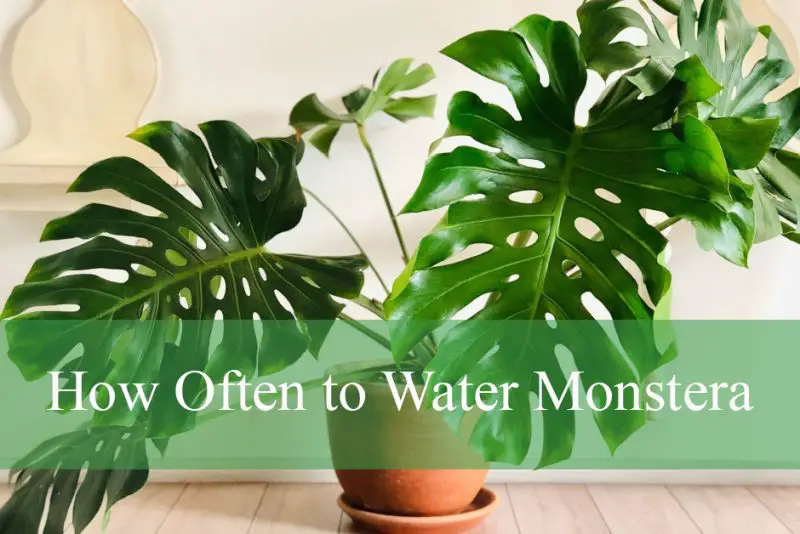Monstera deliciosa, commonly known as the Swiss cheese plant or split-leaf philodendron, is a tropical plant loved for its striking foliage and relatively easy maintenance. Its broad, glossy leaves with unique holes and splits add a lush, exotic touch to any indoor or outdoor garden. However, watering Monstera correctly can be a challenge, especially when comparing indoor versus outdoor care. Watering too much or too little can cause problems such as root rot, yellowing leaves, or stunted growth.
This comprehensive guide explores how often you should water your Monstera indoors and outdoors, covering important environmental factors, soil considerations, seasonal variations, and how to identify your plant’s specific needs. By understanding these differences, you’ll be equipped to help your Monstera thrive in any setting.
Understanding Monstera’s Water Needs

Water is critical to the health of any plant, and Monstera is no exception. As a tropical rainforest native, Monstera is adapted to consistently moist but well-draining soils. It requires enough water to keep its cells hydrated for photosynthesis and nutrient transport, yet it is intolerant of sitting in soggy soil which can suffocate roots.
One of the biggest challenges with watering Monstera is maintaining balance. Unlike desert succulents that thrive on infrequent watering, or tropical plants that thrive in constant moisture, Monstera needs a “moist but not wet” environment. Watering frequency and amount must be carefully adjusted based on the plant’s surroundings, whether inside your home or in an outdoor garden.
How Water Supports Monstera Growth
Water plays several vital roles for Monstera. It transports nutrients from the soil into the plant’s roots and throughout the leaves. It provides the turgor pressure that keeps leaves firm and upright. Water also enables photosynthesis, the process by which plants convert sunlight into energy.
Without adequate water, Monstera leaves will begin to droop and wilt. Over time, chronic dehydration can cause leaf edges to brown and curl, reducing the plant’s beauty and health. Conversely, excess water can drown roots, limit oxygen availability, and encourage root rot, fungal infections, and pest problems.
Key Factors That Influence How Often to Water Monstera
Indoor vs. Outdoor Environment
The environment plays a major role in watering needs. Indoor Monsteras typically enjoy stable temperatures, indirect light, and controlled humidity levels. These conditions slow evaporation and reduce water loss from the soil and leaves.
Outdoor Monsteras, however, are subject to varying temperatures, direct sunlight, wind, and rain. These factors accelerate soil drying and increase the plant’s water demands. Outdoor Monsteras in hot, dry climates may need watering every few days, while those in mild, humid areas might require less frequent irrigation.
Pot Size, Material, and Soil Type
The size and type of pot directly influence how quickly soil dries. Smaller pots hold less soil and tend to dry out faster. Porous pots made from terracotta or unglazed ceramic allow moisture to evaporate more quickly than plastic or glazed pots, affecting watering frequency.
Soil composition is equally important. A well-draining potting mix, often composed of peat moss, perlite, and orchid bark, holds enough moisture while allowing excess water to drain. Heavy soils with poor drainage retain water too long, increasing the risk of root rot.
Seasonal Changes
Monstera’s growth and water needs fluctuate with the seasons. During spring and summer, when the plant actively grows, water consumption increases. In fall and winter, growth slows or becomes dormant, reducing the amount of water the plant requires. Indoor heating during winter can dry air, which may increase water loss from the plant despite cooler temperatures.
Light Exposure and Humidity
Light intensity and humidity also affect watering needs. Stronger light increases transpiration—the process by which plants lose water through leaves—leading to greater water demand. In a dry environment with low humidity, water evaporates from the soil and plant surface faster, requiring more frequent watering.
Conversely, shaded, humid environments slow evaporation, reducing the frequency of watering.
How Often to Water Monstera Indoors
Typical Indoor Watering Schedule
Indoors, Monsteras usually need watering every 7 to 14 days. However, this varies widely based on environmental factors. The best method to determine when to water is by checking soil moisture rather than sticking to a strict schedule.
Most plant enthusiasts find that testing the top 1 to 2 inches of soil with a finger is effective. If the soil feels dry, watering is needed. If it still feels moist, waiting a few more days helps prevent overwatering.
How to Water Monsteras Indoors Properly
When you water indoor Monstera, do so thoroughly. Water the plant until it drains freely from the pot’s drainage holes. This ensures water reaches the entire root ball. Empty excess water from saucers or trays to prevent standing water, which can promote root rot.
Indoor air can often be dry, especially in winter due to heating. To support Monstera health, consider increasing ambient humidity through misting, pebble trays, or humidifiers. Higher humidity reduces water loss from leaves, potentially reducing how often you need to water.
Signs Your Indoor Monstera Needs Water
Indoor Monsteras typically show subtle signs when thirsty. Leaves may start to droop or curl slightly. The edges might brown if underwatering persists. Checking soil moisture is the best way to avoid guessing and keep the plant healthy.
Yellowing leaves often indicate overwatering. If leaves are wilting and the soil is wet, it’s likely the roots are struggling due to excess water.
How Often to Water Monstera Outdoors
Outdoor Watering Frequency and Considerations
Outdoor Monsteras are subject to environmental conditions that dramatically affect how quickly soil dries out. In warm, sunny climates, watering every 2 to 5 days may be necessary, especially during peak summer heat. In cooler or more humid regions, watering once per week or less may be sufficient.
Rainfall naturally supplements outdoor watering, but it is important to monitor soil moisture after rains to prevent overwatering. If rainfall is abundant, supplemental watering may be unnecessary for days or weeks.
Wind exposure can dry soil rapidly. If your outdoor Monstera is in a windy area, it will likely require more frequent watering.
Outdoor Watering Techniques for Healthy Growth
For outdoor Monsteras, deep watering is important. Deep soaking encourages roots to grow downward, which increases drought tolerance and plant stability. Water slowly and allow it to soak into the soil to a depth of at least six inches.
Mulching around the base of the plant with organic materials like bark chips or straw helps retain moisture, regulate soil temperature, and reduce evaporation. This is especially helpful in hot, dry climates.
Be cautious of heavy rainfall or poorly draining soil, as waterlogged conditions can lead to root rot. In such cases, improving soil drainage or elevating planting beds may be necessary.
Identifying Outdoor Watering Needs
Outdoor Monsteras will show similar signs of underwatering and overwatering as indoor plants. Wilted or drooping leaves, brown tips, and dry soil point to insufficient water. Yellowing leaves and soggy soil often indicate too much water.
Checking soil moisture regularly, especially during dry or hot periods, is key to preventing stress.
Adjusting Watering Through the Seasons
Spring and Summer
Spring and summer bring vigorous growth and increased water needs for Monstera. During these seasons, watering frequency should increase, and soil should remain consistently moist. Both indoor and outdoor Monsteras benefit from more frequent watering, but soil should never be soggy.
Fall and Winter
Monstera enters a slower growth or dormant phase in fall and winter. Watering should be reduced accordingly. Indoor Monsteras may only need watering every two to three weeks, while outdoor plants might require watering only when rainfall is scarce.
Seasonal humidity changes should also be considered. Indoor humidity is often lowest in winter, which may counterintuitively increase watering needs despite cooler temperatures.
Choosing the Right Soil and Pot for Optimal Watering
Soil and pot selection are crucial to successful Monstera watering. A light, well-draining soil mix allows excess water to escape and prevents waterlogging. Components like peat moss, perlite, and orchid bark create the ideal medium.
Pot material affects evaporation rate. Terracotta pots are porous and allow moisture to escape quickly, requiring more frequent watering. Plastic or glazed ceramic pots retain moisture longer.
Always choose a pot with drainage holes to avoid standing water and root problems.
FAQ About How Often to Water Monstera
How often should I water my Monstera indoors?
Typically, indoor Monsteras need watering every 7 to 14 days. However, it’s best to check the top 1-2 inches of soil—if it feels dry, it’s time to water. Factors like humidity, temperature, and pot size can affect this frequency.
How often should I water my Monstera outdoors?
Outdoor Monsteras generally require watering every 3 to 7 days, depending on the weather, soil type, and exposure to sun and wind. During hot or dry spells, more frequent watering may be necessary.
What are the signs that my Monstera is overwatered?
Overwatered Monsteras often show yellowing leaves, wilting despite moist soil, and sometimes a musty smell from the soil. Root rot may develop if overwatering persists.
What are the signs that my Monstera is underwatered?
If underwatered, Monsteras may have drooping or curling leaves, dry or crispy leaf edges, and slowed growth. The soil will feel dry well below the surface.
Can I use a fixed watering schedule for Monstera?
Using a fixed schedule can lead to problems because Monstera’s water needs vary with environment and season. It’s better to monitor soil moisture and plant condition to decide when to water.
Does the size or type of pot affect watering frequency?
Yes, smaller pots and porous pots like terracotta dry out faster and require more frequent watering than larger or plastic pots.
Conclusion: Balancing Watering for Healthy Monsteras Indoors and Outdoors
Watering Monstera is a delicate balance that depends on many factors, especially whether the plant is indoors or outdoors. Indoor Monsteras generally need watering every 7 to 14 days, while outdoor plants may require more frequent watering depending on sun, wind, rainfall, and temperature.
By observing your plant’s condition, testing soil moisture, adjusting watering according to season, and providing proper soil and pot conditions, you can ensure your Monstera thrives wherever it grows. Remember that healthy Monsteras have vibrant, glossy leaves and steady growth—signs that your watering routine is on point.






